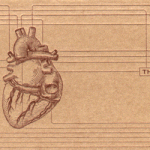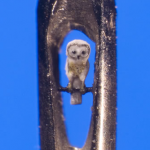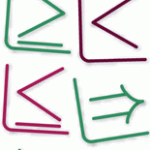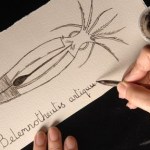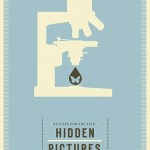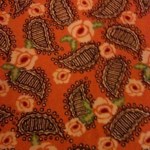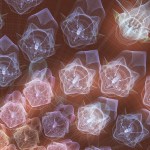
This enraged, possibly rabid, antlered and befanged squirrel (?) encapsulates the spirit of my week so well, I just had to share. TGIF, friends.
Via Crappy Taxidermy, of course.
This ad for Scribe notebooks - depicting a world of doodle-covered scratchpaper - is almost entirely created with digital imaging software. Am I the only one who finds that a little ironic?
Via NotCot.
This morning, I'd like to point out two interesting stories on how the health care debate has become more irrational than rational. First, a WaPo op-ed decrying the imbalanced media coverage of health care, which may be leading to a perception that opposition is larger than it really is:
The most disturbing account came from Rep. David Price of North Carolina, who spoke with a stringer for one of the television networks at a large town-hall meeting he held in Durham. The stringer said he was one of 10 people around the country assigned to watch such encounters. Price said he was told flatly…
Blue Barnhouse Letterpress is simply awesome. I was idly coveting these classy anatomical heart thank-you cards when I discovered they actually have a special card FOR COLONOSCOPIES:
No, not even letterpress can make these brutal (and hopefully fictitious) colonoscopy implements "classy." But that's not stopping me from blogging it.
The Science and Entertainment Exchange blog has an interesting post up about artist Willard Wigan, who creates sculptures that can only be seen through a microscope.
Wigan's story is touching - he started sculpting as a child, when his dyslexia made school a painful challenge. He says,
"I started making houses for ants because I thought they needed somewhere to live. Then I made them shoes and hats. It was a fantasy world I escaped to."
(That totally reminds me of the scene from Zoolander where the none-too-bright model played by Ben Stiller stares at a scale model of a proposed school…
Science's July issue has an interesting article about mathematician Byron Cook, who teamed up with artist Tauba Auerbach to create nine new mathematical symbols. The symbols were intended to make the notation for Cook's work on a particular mathematical problem, called the "halting problem," more intelligible:
"When I was giving lectures or talking to product developers, I needed to get a lot of information across quickly, and this was getting difficult," says Cook. Things got even tougher when he began to write a book on the subject.
The article includes some interesting tidbits about the…
I'm still tickled by the British scientists who discovered a cache of ancient squid ink and used it for. . . art:
Paleontologists discovered the remains of the creature, called a Belemnotheutis antiquus, during a dig at a Victorian excavation in Trowbridge, Wilts. They cracked open what appeared to be an ordinary looking rock only to find the one-inch-long black ink sac inside. After realising what they had stumbled across, they took out a small sample of the black substance and ground it up with an ammonia solution. Remarkably, the ink they created was good enough to allow them to draw the…
An irreverent, sometimes wince-inducing, profoundly touching sampler of the ephemeral moments we take for granted:
Video by Will Hoffman and team, found via Scibling/author Jonah Lehrer.
Lovely minimalist poster design from Jordan Michael Gray's flickrstream.
via NOTCOT.
"Neurosigntist" and blogger John Ohab sent me this photo of garish carpet in a Vegas hotel. It appears to depict mitochondria on a field of roses. And it's really, really ugly. Thanks John!
For me, back-to-school shopping was always accompanied by a frisson of anticipation and excitement. It was the only time of year I actually got to go on a shameless shopping spree - which required leaving town and adventuring an hour or two north to find a wider selection of department stores. I didn't care about clothes much, so it wasn't the clothes I really cared about, but what they represented: the possibility that if I just hit on the right costume, the right ensemble of luscious jewel-toned sweaters and tights and matching socks (this being the 80s and 90s), I'd suddenly enter into a…
Notice--Forest (McDonald's paper bag)
Paper Bag, Glue
Yuken Teruya, 2005
Paper artist Yuken Teruya does the impossible by turning a fast food bag into a stunning sunset-dappled lone tree. The Forest Series, creating paper trees out of disposable waste products like toilet paper tubes and paper bags, is a poignant glimpse of the forest behind the paper - it's a like a little bit of the lost trees' spirit lives on in the consumer end product. Yes - even McDonald's bags were once alive!
There's also something magical about looking from the inside of the bag outwards, sneaking behind the garish…
No, I'm not being rude, I promise! The Gates Foundation is matching DonorsChoose donations to high-need schools. They'll fund 50% of any classroom project request that prepares students in rural and high-poverty schools for college, up to $4.1 million.
Just jump in and pick from a list of projects eligible for matching funds here. Here's a project that caught my eye:
One of my former students had done water rockets at his school in another state. He introduced this to me and I have been hooked on it ever since then. Normally, I have teaching funds from our state. This year my funds have been…
H. annuus
Macoto Murayama
Nanobots? Alien spaceships? A scene from TRON? No, it's illustrator Macoto Muriyama's delicate diagrams of flower structure. Muriyama says,
Generally, a plant is considered to be a being that has an organic form. However, that is just one of the aspects because along with their organic form, a plant possesses a contradictory element of geometric/mechanical structure. By highlighting the later, the plant's out-of-the-ordinary form is revealed, and in it, a different kind of attractiveness can be found. (source)
See an entire gallery of Muriyama's work at Pink…
I read Scibling Jonah Lehrer's How We Decide some time ago, but Moveable Type ate my half-finished review, and it's taken me until now to get back to it. You may have seen quite a few reviews elsewhere by now - Adam Kepecs reviewed it for Nature back in April, and to make a long story short, I largely agree with him: Lehrer is a very good writer, but this is not a great book.
Lehrer starts his book with an airplane anecdote, so I'll do the same - although his opening anecdote is about crashing a plane (albeit a simulated plane), so I'm not sure I'd recommend the book for nervous flyers.…
BIKES
cardboard and glue, life size
Chris Gilmore, 2003
I've been unpacking after the move, which means I'm surrounded by piles of cardboard boxes that need to be broken down and recycled. I wish I had Chris Gilmore's skill with cardboard! He sculpts machines and mechanisms, from Fiats to typewriters, entirely in quotidian corrugated cardboard and glue - materials we rarely think about and accord very little respect. Of course, these lightweight mimics don't actually function - but that makes a neat statement too, since so many of the everyday objects he sculpts are primarily functional, not…
Photographer: Rudy Huhold
Agency: Artplan
Apparently package delivery service Sedex Express is quite similar to. . . your brain on drugs. Hmmmm.
Via fubiz
It commemorates Hans Christian Ãrsted, who discovered the relationship between electricity and magenetism. Re-enact Ãrsted's experiment here.
But what about that other Hans Christian, Hans Christian Andersen? Here's what the Guardian had to say: "while there's nothing wrong with fairy stories, they haven't contributed much to the development of electric motors."
Ouch! :)
How NOT to practice medicine - no matter how bad the health care situation gets:
Benson has no medical degree. His expertise comes from his youth, which was spent on a farm in Indiana. "When one of us needed medical attention," he told me, "we dipped into our veterinary supplies." According to Benson, many pharmaceuticals for animals are the same as those formulated for humans, and can be purchased without a prescription at veterinary supply stores, of which most rural communities have several. In figuring out how to translate livestock dosages to human ones, Benson offers this jaunty rule of…
Artist Emmanuel Polanco does amazing collage work reminiscent of Eduardo Recife. I especially like this piece, but he has several more with more overt vintage-science content. See a gallery at Fubiz.

